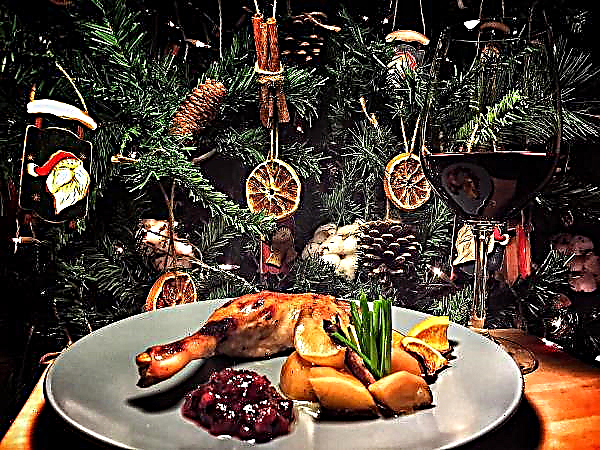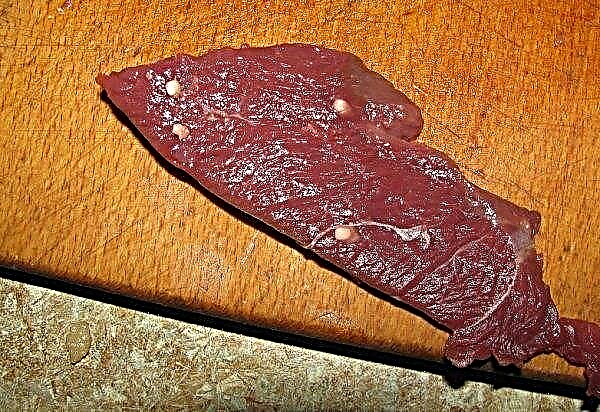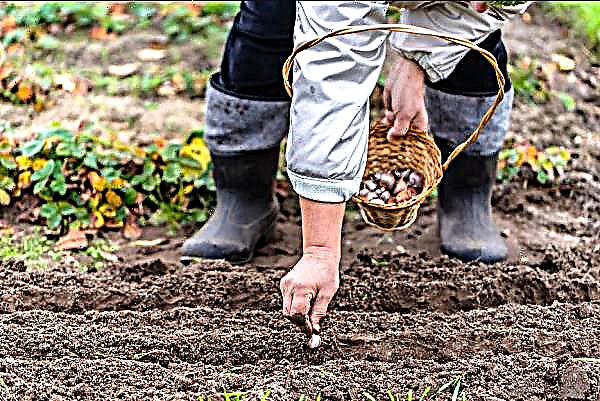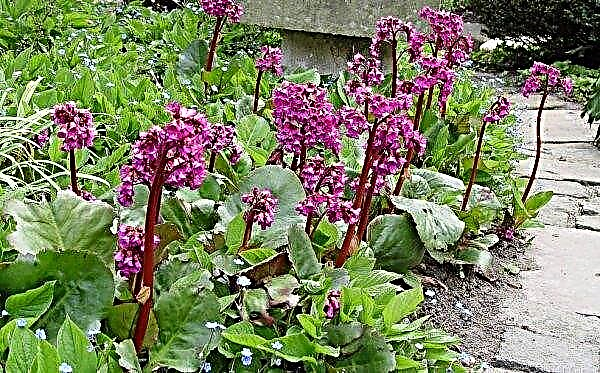Tomato "Peach" is one of the modern high-quality varieties developed by Russian breeders. Its main advantage is the original color, for which this species received well-deserved respect both among gardeners and consumers.
Grade description
The variety was bred by the Russian company Gavrish in 2002 and registered in the state register of the Russian Federation under the name “Peach”. Indicators among tomatoes are common, but it differs in color and precocity.
Tomato "peach" has various color options, it can be orange, pink and even red. But its main color is shades of orange.
The main characteristics of the variety are:
- bush of determinant type with a small height of growth - up to 60 cm;
- the foliage of the bush is dark green, small, dense;
- ripening period of tomatoes - 85–95 days;
- average fruit weight - up to 110 g;
- average productivity - 6–8 kg per 1 m²;
- up to 4 bushes can coexist on 1 m²;
- smooth, rounded, yellow-orange and orange-cream fruits with a slight edge;
- up to 8 tomatoes are formed on the brush;
- the taste is sweet, delicate, without sourness, with a fruity aftertaste;
- recommended for baby food;
- growing area: Ukraine, Belarus, all of European Russia, except for the northern regions, and some areas of the Asian part.

Advantages and disadvantages
- The advantages of this variety are the following indicators:
- beautiful appearance of the bush and fruits;
- excellent taste of the fruit;
- precocity
- prolonged fruiting;
- suitable for harvesting in the form of pickles, pasta, ketchup;
- unpretentiousness to natural conditions.
- Disadvantages of the "peach" are also available:
- low bush;
- low productivity;
- the need for frequent fluffing of the garden bed.
Did you know? There is a lot of confusion around the name about the variety. This officially registered species is often confused with similar ones - «Garden peach», «Red peach», «Chinese velvet» and even with «Apricot».
Self-growing seedlings
All undersized tomatoes are grown using the same technology. There is no need to hammer high stakes into the ground with several levels of ropes for garter.
Sowing dates
Seeds for seedlings are planted from the second half of March until mid-April. Too early planting is fraught with a situation where the temperature regime does not yet allow the bushes to be transferred to the open ground, and they have already outgrown the containers in which they were planted. Being late with the planting can lead to the fact that the fruits simply do not have time to ripen.
The determinant varieties of tomatoes also include such as:
The soil
A standard soil mixture is used for tomatoes and peppers - this composition is ideal for most varieties of tomatoes. When using purchased soil, disinfection is not necessary. If the land is used from a garden, a summer residence or a field, before laying the seeds, it is necessary to conduct heat treatment of the soil.
This is done by heating on a baking sheet or by steaming in a water bath.
Capacity for growing
There is not much difference in what capacity seedlings will be grown. The main thing is that the developing plant roots do not stumble on the barrier in the form of container walls. Ordinary plastic cups will work, but it is better to use spacious trays for growing in a group way. Sprouts also feel good in peat briquettes or cups.
Seed preparation
Preparation of material for planting is carried out in three stages:
- disinfection with a weak solution of potassium permanganate;
- growth stimulant treatment;
- Placement on wet natural fiber fabric prior to pitting.
Sowing seeds
After the treated seeds have hatched on a damp cloth, they are planted in the prepared soil. The depth of the bookmark should be no more than 1 cm. The distance between the planted seeds is also 1 cm.
Important! All manipulations must be carried out very carefully so as not to damage the tender swollen seeds.
Seedling Care
Immediately after laying the seeds in a container with soil, it is necessary to cover them with a transparent film for several days - ideally before the first seedlings appear. This will help moisture condensation and constant wetting of the soil. Improving the conditions for growing plants in the form of planting is carried out after the appearance of two full leaves. The sprouts will simply become crowded and they may disappear. For seating, you need to prepare a container with holes at the bottom so that excess moisture can come out of the ground.
The sprouts will simply become crowded and they may disappear. For seating, you need to prepare a container with holes at the bottom so that excess moisture can come out of the ground.
You need to water the seedlings as the soil dries, but not too often. It is better to give a lot of water at a time than to add a little daily. It is also important to pour water directly into the soil, and not onto the plant itself, so as not to damage its delicate leaves.
Seedlings are best placed on a sunny, but slightly shaded window sill, so that the scorching rays of the sun do not damage the fragile sprouts. The southeast windowsill will do well when the morning sun warms up the soil and shines on seedlings, and already in the afternoon there will be a pleasant shadow over the shoots.
It is difficult to determine the temperature regime precisely, since it depends on the illumination, access of direct rays, and the isolation of the room. Seedlings are afraid of drafts, so ventilation should not turn into whistling air currents.
Important! The optimum temperature for seedlings varieties «Peach» considered to be +20 ° C. If this temperature is not always possible to withstand, it is worth moving containers with sprouts from the window.
Seedling hardening
A week or two before the seedlings are transplanted into the open soil, it is recommended to harden them. Trays or cups with seedlings are taken out into the fresh air for several hours, after a few days the period increases, and then young bushes are carried out for the whole night.
You can also start ventilating the room with plants. Such measures will help tomatoes quickly adapt to new living conditions when transplanting to the garden.
Planting seedlings in a permanent place
You can transplant the bush into the ground somewhere at the end of May, the usual age for this is about 50 days after hatching. By this time, 10 leaves are already being formed, and the height reaches 20–25 cm. Such a seedling can be transplanted into the garden, or if the climatic regime still does not allow it, then to the greenhouse. Considering the small size of the bushes, they can be planted at a distance of 40 cm from each other, and row spacings should be up to 70 cm. Before planting, the soil is dug up in advance (for 2-3 weeks), beds or holes are made, which are watered and fertilized with humus or mineral fertilizers and processed with blue vitriol.
Considering the small size of the bushes, they can be planted at a distance of 40 cm from each other, and row spacings should be up to 70 cm. Before planting, the soil is dug up in advance (for 2-3 weeks), beds or holes are made, which are watered and fertilized with humus or mineral fertilizers and processed with blue vitriol.
Tomato bushes do not plant in those areas where potatoes grew last year, but after cucumbers, carrots and zucchini, this is possible and necessary. Also, when landing, cloudy weather is desirable so that the seedlings have time to adapt to new conditions in a fairly mild climate.
Features of outdoor care
After all the worries at the stage of growing seedlings, new troubles appear for caring for plants in the open ground. It is necessary to organize proper watering, plant nutrition, treatment from pests, care for the structure of the bush.
Watering
The plant should not be filled with water in the hope that it will grow faster - in this way the root system can be damaged. Depending on the weather, the bushes are watered once every 2 days in hot weather, and once every 3-5 days in cool weather.
Watering is necessary under the roots, avoiding spraying on the leaves, and especially on inflorescences or fruits. After the past rain, it is worth assessing how much the soil is saturated with moisture, and then decide on the need and timing of irrigation.
Fertilizer application
Fertilizers are initially applied to the soil when preparing a landing site. Further, the plant is left alone for at least 10 days. Then it can be fed with mineral fertilizers every 10-12 days. Organic substances are not used at this time, since the soil is already saturated with them, and excess can lead to diseases of the root system. After the fruits have already been tied up, the intervention in the soil is stopped and they are waiting for a full crop.
Organic substances are not used at this time, since the soil is already saturated with them, and excess can lead to diseases of the root system. After the fruits have already been tied up, the intervention in the soil is stopped and they are waiting for a full crop.
Shaping and tying a bush
The plant is formed into one stem, all side processes are removed and there is no need for pinching in the future. The “Peach” bush is low and will require garter only when it reaches a height of more than 40 cm at the beginning of fruit set.
Gardeners manage with one garter, which is enough until the tomatoes mature completely. For plants of this not very productive variety such care is quite enough.
Did you know? Two glasses of tomato juice contain a daily intake of vitamins A and C, which strengthen immunity well.
Soil care
The qualitative growth of bushes and fruiting is well affected by loosening and mulching the soil near the stem of the plant.
You can mulch:
- straw;
- mowed grass;
- sawdust.
 There are different opinions about the need for weed weeding - some gardeners think that tomatoes are more comfortable in weed thickets, others believe that weed picks up “juices” from bushes.
There are different opinions about the need for weed weeding - some gardeners think that tomatoes are more comfortable in weed thickets, others believe that weed picks up “juices” from bushes.As practice shows, the latter are right, since smaller fruits ripen in the thickets of weeds, the quantity and quality of the ovaries deteriorates, and the susceptibility to diseases increases.
The peach tomato variety is more decorative, so farmers rarely cultivate it, but it can often be found in summer cottages and household plots. This is the decoration of the garden, and the opportunity to pamper the household with original and tasty tomatoes.












